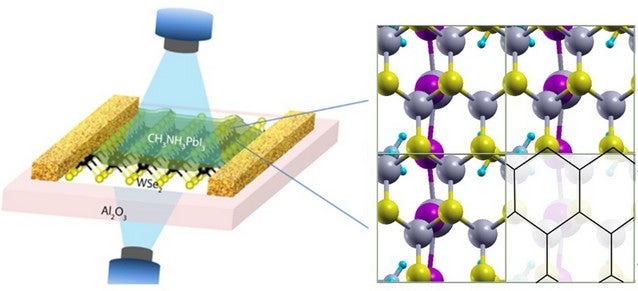High photoconductivity from hybrid bilayer
SOW Chorng Haur (Group Leader, Physics) () October 06, 2016
6 Oct 2016. NUS physicists have developed a high performance photodetector built on ahybrid bilayer of tungsten diselenide (WSe2) and perovskite.
WSe2 is a new class of two-dimensional (2D) material with potential applications for novel optoelectronic devices. However, the intrinsic defects caused by the selenium vacancies lower the electrical conductivity and photoconductivity of the WSe2 monolayer, restricting its use in various applications. Recently, many research activities have been carried out by various international research groups to “heal” these defects in the WSe2 monolayers.
A team led by Prof Chorng Haur SOW, from the Department of Physics, NUS has developed a method to “heal” the defects present in the WSe2 monolayers. They developed effective methods for enhancing the performance of a WSe2 monolayer photodetector using laser tailoring and perovskite functionalisation.
The team deposited a thin layer of organolead halide perovskite (CH3NH3PbI3) via thermal evaporation onto a specially prepared WSe2 monolayer. The unique combination of the focused laser beam technique to heal the defects in WSe2, together with the use of the large absorption coefficient material CH3NH3PbI3, led to the development of a high performance hybrid bilayer photodetector with an enhanced output which is three orders of magnitude better than the pristine device.
This carefully engineered approach represents a significant step towards improving the performance of 2D optoelectronics, extending the applications of 2D semiconductors in optical communication, integrated micro/nano-circuits, quantum information technology etc.

Figure shows the schematic diagram of a hybrid bilayer photodetector (left) and atomic structure of the interface of WSe2–CH3NH3PbI3.
References
JP Lu, A Carvalho, HW Liu, SX Lim, ZL AH Castro Neto, CH Sow. “Hybrid Bilayer WSe2-CH3NH3PbI3 Organolead Halide Perovskite as High Performance Photodetector”, Angewandte Chemie, 128, 12124-12128 (2016). DOI: 10.1002/anie.201603557.
JP Lu, A. Carvalho, XK Chan, HW Liu, B Liu, ES Tok, KP Loh, AHC Castro Neto, CH Sow. “Atomic Healing of Defects in Transition Metal Dichalcogenides”. Nano Lett. 15, 3524 (2015).


